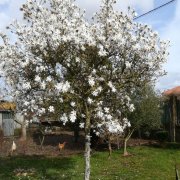Care of the tree Magnolia stellata or Star magnolia |
|
The genus Magnolia, family Magnoliaceae, includes about 120 species of trees native to the American continent and Southeast Asia. Some species are: Magnolia stellata, Magnolia liliiflora, Magnolia grandiflora, Magnolia boliviana, Magnolia liliifera, Magnolia officinalis, Magnolia × soulangeana. Common names: Star magnolia, Starry magnolia. This species is native to Japan. They are deciduous trees or shrubs of compact size and slow growth that reach 4 meters (13.12 feet) in height; the bark and leaves are aromatic. The leaves are obovate or elliptical in shape and deep green (golden yellow in autumn). The attractive and elegant scented flowers are star-shaped, up to 15 cm (5.9") in diameter, and white in color (pink varieties exist). They bloom in spring. Star magnolia is used as isolated specimens (arboreal bearing) and in groups (shrub bearing). It's not recommended for gardens with a Mediterranean climate. Magnolia stellata grows in semi-shade and full sun exposures and in cool-temperate climates. It resists not very intense frosts. Starry magnolia prefers light, deep soils that contain abundant organic matter; they do not resist calcareous soils. Water regularly so that the substrate never dries completely; increase watering in summer. Magnolia stellata does not resist drought. Fertilize with organic matter in fall or late winter and with slow-release mineral fertilizer in early spring. Star magnolia is not usually pruned but can be pruned in autumn to achieve a tree-like appearance. Magnolia stellata can be attacked by Chlorosis if the soil is alkaline. Starry magnolia is propagated by air layering in summer and by cuttings in autumn. |
Images of the tree Magnolia stellata or Star magnolia |
Find plants
Magnolia stellata or Star magnolia | Care and Growing
© 2026 FavThemes
